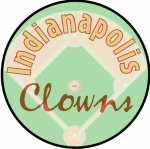The Indianapolis Clowns were a professional baseball team in the Negro American League. Tracing their origins back to the 1930s, the Clowns were the last of the Negro league teams to disband, continuing to play exhibition games into the 1980s. They began play as the independent Ethiopian Clowns, joined the Negro American League as the Cincinnati Clowns and, after a couple of years, relocated to Indianapolis. Hank Aaron was a Clown for a short period, and the Clowns were also one of the first professional baseball teams to hire a female player.
| Indianapolis Clowns | |
|---|---|
 | |
| Information | |
| League |
|
| Location | Indianapolis, Indiana |
| Ballpark |
|
| Established | c. 1930s |
| Disbanded | 1962 |
| Nickname(s) |
|
History
editFounding
editBefore becoming the Ethiopian Clowns, there is evidence indicating that the team was formed in Miami, Florida, in 1935 or 1936 by Hunter Campbell and bootlegger Johnny Pierce,[2] and was known as the Miami Giants, and, by 1941, as the Miami Ethiopian Clown.[3] The team became an independent barnstorming club, shortening its name to the Ethiopian Clowns. Syd Pollock was instrumental in promoting and popularizing the Clowns and developed them into a nationally-known combination of show business and baseball that earned them the designation as the Harlem Globetrotters of baseball.[citation needed]
In 1943, the team was relocated to Cincinnati, where they became the Cincinnati Clowns. That same year they joined the Negro American League, beginning a 12-year membership in the circuit before withdrawing following the 1954 season. The team operated between Cincinnati and Indianapolis in 1944 and 1945 before officially moving to Indianapolis in 1946, playing as the Indianapolis Clowns for the rest of their existence.
The team won the league championship in 1951, 1952, and 1954.
Barnstorming
editWhile still fielding a legitimate team, the Clowns also toured with several members known for comic acts — sort of a baseball version of the Harlem Globetrotters, including Joe "Prince" Henry. As the Negro leagues declined in the late 1940s after the integration of Major League Baseball, the Clowns continued operations on barnstorming tours into the 1960s. The team relocated from Indianapolis to Offermann Stadium in Buffalo, New York, in 1951, while retaining the Indianapolis Clowns name. The Clowns left Buffalo after the 1955 season.[5]
By 1967 the Indianapolis Clowns were the last Negro league team still playing. The Clowns continued to play exhibition games into the 1980s, but as a humorous sideshow rather than a competitive sport. After many years of operation as a barnstorming team, the Clowns finally disbanded in 1989.[6]
Hank Aaron and other notable players
editBy 1952, Syd Pollock signed Hank Aaron to his first professional contract, at $200 a month. Aaron played about three months as the Clowns' shortstop and cleanup hitter before being acquired by the Boston Braves organization for $10,000.
The Clowns fielded such stars as Buster Haywood, Hubert "Big Daddy" Wooten, DeWitt "Woody" Smallwood, showman and Harlem Globetrotter star "Goose" Tatum, and future Major Leaguers John Wyatt (Kansas City Athletics), Paul Casanova (Washington Senators), Hal King (Atlanta Braves), and Choo-Choo Coleman (New York Mets).
Female players
editThe Clowns were the first professional baseball team to hire a female player to a long-term contract that was not voided soon after. In an effort to replace Hank Aaron, who had left the team the previous year, the Clowns hired Toni Stone to play second base with the team in 1953, in which she batted .243.[7] The following year the Clowns sold her contract to the Kansas City Monarchs. They hired two women replacements: Pitcher Mamie "Peanut" Johnson, who would go on to record a record of 33-8 while batting between .262 to .284[8] on the team, and second baseman Connie Morgan. Women also served as umpires for the team; notably, former Chicago model Nancy Miller, was the first female umpire in pro ball.
Cinematic legacy
editThe 1976 movie The Bingo Long Traveling All-Stars & Motor Kings, starring James Earl Jones, Billy Dee Williams, and Richard Pryor, is loosely based on the barnstorming of the Indianapolis Clowns.
References
edit- ^ a b Ashwill, Gary. "Indianapolis Clowns". Negro Leagues Database. Seamheads.com. Retrieved 15 August 2022.
- ^ Neil Lanctot, "Negro League Baseball: The Rise and Ruin of a Black Institution." U. Penn. Press, 2004, p. 108.
- ^ Staff writer (April 10, 1941). "Kansas City Monarchs Tackle Ethiopians". The Philadelphia Tribune. p. 11.
- ^ "Pennant for the Cincinnati Clowns". Smithsonian Institution. Retrieved 2021-11-12.
- ^ Graham, Tim (22 September 2004). "Class Clowns The Indianapolis Clowns Have A Rich Place In Buffalo Baseball History; For Example, Hank Aaron Was "Discovered" At Offermann Stadium". The Buffalo News.
- ^ "History of the Indianapolis Clowns" (PDF). The Center for Negro League Baseball Research. Retrieved 2014-09-20.
- ^ NLBPA (April 21, 2007). "Toni Stone". NLBPA. Archived from the original on April 16, 2007. Retrieved 2007-04-21.
- ^ Green, Michelle Y. (2002). A Strong Arm: The Story of Mamie "Peanut" Johnson. New York: Dial Books for Young Readers. ISBN 978-0-8037-2661-1.
Sources
edit- The Biographical Encyclopedia of the Negro Baseball Leagues – James A. Riley. Publisher: Chelsea House, 1996. Format: Paperback, 124pp. Language: English. ISBN 0-7910-2592-6
Further reading
edit- Heward, Bill. Some are called Clowns: A season with the last of the great barnstorming baseball teams, ISBN 0-690-00469-9.
- Pollack, Alan J. (Author), James A Riley (Editor), "Barnstorming to Heaven: Syd Pollock and His Great Black Teams", ISBN 978-0817314958.